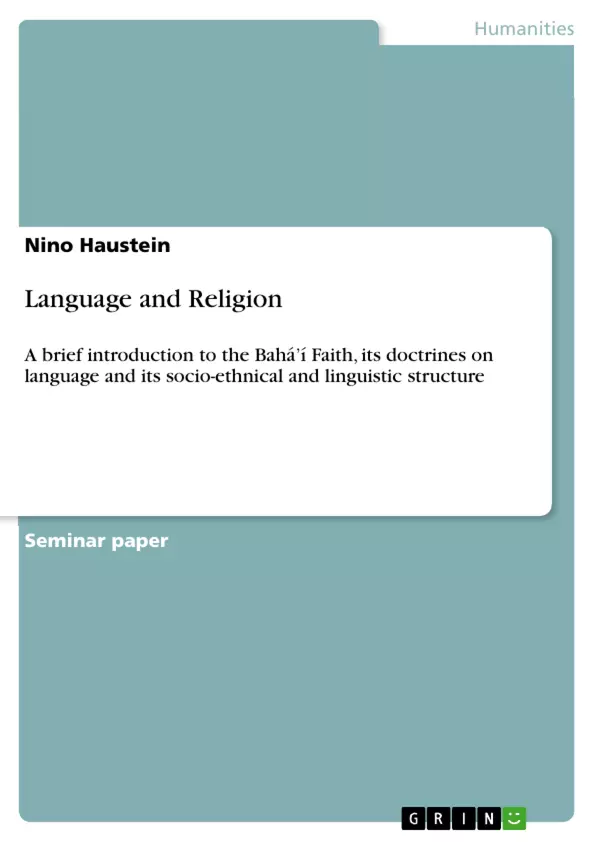This seminar paper deals with links and relations between language and religion.
Exemplarily, it takes a closer look at the connections of language and the Baha’i Faith in general and, in particular, in Germany. Therefore, the paper focuses on the historical development of this world religion, beginning in 19th-century Iran, its evolution towards a global faith, and its establishment in Germany in the early years of the 20th century. This paper is also going to deal with religious teachings that influence the ethnic, racial, social and linguistic structure of this young world faith. Furthermore, an insight into statistics on the ethnical, racial, and cultural backgrounds of the global and the German Baha’i community respectively as well as conclusions about their linguistic composition will be provided. In the end, details about a survey conducted from February 06th 2013 to March 17th 2013 will be presented and elaborated on.
Only little research has been conducted in the field of language and the Baha’i Religion – at least from a sociolinguistic perspective. Therefore, this paper serves as a good opportunity to deal with this challenge.
Table of Contents
- Introduction
- The Baha'i Faith and some of its Central Teachings
- The Socio-Ethnic Structure of the Baha'i Religion
- A Survey Concerning the Ethnical and Linguistic Structure of the German Baha'i Community
- Introduction to the Survey & Assumptions for the Creation of the Questions
- The Statistic Outcome of the Survey
- An Evaluation of the Survey
- Bibliography
Objectives and Key Themes
This seminar paper explores the relationship between language and religion, particularly within the context of the Baha'i Faith. The paper examines the historical development of the Baha'i Faith, from its origins in 19th-century Iran to its global expansion and establishment in Germany. It investigates the influence of Baha'i teachings on the ethnic, racial, social, and linguistic structures of this world religion. The paper also presents a survey conducted among German Baha'is to understand the ethnical, racial, and linguistic makeup of this community. Key themes explored in the paper include:- The unity of humankind and its influence on the Baha'i community
- The importance of language as a tool for promoting world peace and unity
- The role of a universal auxiliary language in facilitating communication and understanding
- The preservation of native languages and cultural diversity within the Baha'i context
- The linguistic composition and socio-ethnical structure of the German Baha'i community
Chapter Summaries
The introduction to this seminar paper outlines the focus on the relationship between language and religion, specifically in relation to the Baha'i Faith. It highlights the paper's examination of the historical development of the Baha'i Faith, its global expansion, and its presence in Germany, with particular attention to the impact of religious teachings on the ethnic, racial, social, and linguistic structures of the Baha'i community. Additionally, the paper prepares readers for the presentation and analysis of a survey conducted among German Baha'is.
The first chapter delves into the core tenets of the Baha'i Faith, which emphasizes the unity of God, the unity of religions, and the unity of humankind. It discusses how these doctrines, particularly the unity of humankind, influence the Baha'i community's embrace of diversity. The chapter explores the Baha'i belief that achieving world peace and unity requires promoting social and religious diversity, while upholding the concept of a united world. The chapter also explores the importance of a universal auxiliary language in promoting global harmony and understanding, a concept that is a central part of the Baha'i Faith's twelve principles.
Keywords
The paper focuses on the relationship between language and religion, exploring the Baha'i Faith as a case study. Key concepts explored include the unity of humankind, a universal auxiliary language, world peace, linguistic diversity, socio-ethnical structure, and the German Baha'i community.- Quote paper
- Nino Haustein (Author), 2013, Language and Religion , Munich, GRIN Verlag, https://www.hausarbeiten.de/document/230824


